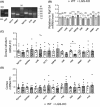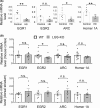Histamine-induced plasticity and gene expression in corticostriatal pathway under hyperammonemia
- PMID: 31571389
- PMCID: PMC7052803
- DOI: 10.1111/cns.13223
Histamine-induced plasticity and gene expression in corticostriatal pathway under hyperammonemia
Abstract
Aims: Histamine H3 receptor (H3R) antagonists/inverse agonists increase vigilance. We studied brain histaminergic pathways under hyperammonemia and the transcriptome of receptors and their signaling cascades to provide a rationale for wake-promoting therapies.
Methods: We analyzed histamine-induced long-lasting depression of corticostriatal synaptic transmission (LLDhist). As the expression of dopamine 1 receptors (D1R) is upregulated in LGS-KO striatum where D1R-H3R dimers may exist, we investigated actions of H3R and D1R agonists and antagonists. We analyzed transcription of selected genes in cortex and dorsal striatum in a mouse model of inborn hyperammonemia (liver-specific glutamine synthetase knockout: LGS-KO) and compared it with human hepatic encephalopathy.
Results: LGS-KO mice showed significant reduction of the direct depression (DD) but not the long-lasting depression (LLD) by histamine. Neither pharmacological activation nor inhibition of D1R significantly affected DDhist and LLDhist in WT striatum, while in LGS-KO mice D1R activation suppressed LLDhist. Histaminergic signaling was found unchanged at the transcriptional level except for the H2R. A study of cAMP-regulated genes indicated a significant reduction in the molecular signature of wakefulness in the diseased cortex.
Conclusions: Our findings provide a rationale for the development of aminergic wake-promoting therapeutics in hyperammonemic disorders.
Keywords: histamine; hyperammonemia; striatum; synaptic plasticity.
© 2019 The Authors. CNS Neuroscience & Therapeutics Published by John Wiley & Sons Ltd.
Conflict of interest statement
The authors declare that they have no conflict of interest. All applicable international, national, and institutional guidelines for the care and use of animals were followed.
Figures








References
-
- Haas HL, Sergeeva OA, Selbach O. Histamine in the nervous system. Physiol Rev. 2008;88:1183‐1241. - PubMed
-
- Wilkinson DJ, Smeeton NJ, Watt PW. Ammonia metabolism, the brain and fatigue; revisiting the link. Prog Neurogibol. 2010;91:200‐219. - PubMed
-
- Wilkinson DJ, Smeeton NJ, Castle PC, Watt PW. Absence of neuropsychological impairment in hyperammonaemia in healthy young adults; possible synergism in development of hepatic encephalopathy (HE) symptoms? Metab Brain Dis. 2011;26:203‐212. - PubMed
Publication types
MeSH terms
Substances
Associated data
- Actions
- Actions
- Actions
- Actions
- Actions
- Actions
- Actions
- Actions
- Actions
- Actions
- Actions
- Actions
- Actions
Grants and funding
LinkOut - more resources
Full Text Sources
Molecular Biology Databases
Research Materials

